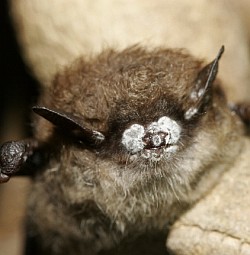 White Nose Syndrome (WNS) describes a series of abnormal behavioural and infectious disease symptoms that have been linked to the deaths of over 6 million bats in North America. The condition was first identified in bat specimens in 2006-2007 in the North-eastern USA, and is named because of the white fungus (Pseudogymnoascus destructans), that infects the skin on the nose, ears, tail and wings of hibernating bats. The infection can spread quickly through physical bat-to-bat contact and results in very high mortality rates within colonies. The disease is spreading rapidly and has now been confirmed in 22 North American states and 5 Canadian provinces.
White Nose Syndrome (WNS) describes a series of abnormal behavioural and infectious disease symptoms that have been linked to the deaths of over 6 million bats in North America. The condition was first identified in bat specimens in 2006-2007 in the North-eastern USA, and is named because of the white fungus (Pseudogymnoascus destructans), that infects the skin on the nose, ears, tail and wings of hibernating bats. The infection can spread quickly through physical bat-to-bat contact and results in very high mortality rates within colonies. The disease is spreading rapidly and has now been confirmed in 22 North American states and 5 Canadian provinces.
Symptoms in affected bat colonies during the hibernation period can include;
- Dead and dying bats clustered around hibernacula entrances
- Dehydration and emaciation from premature torpor arousal
- Outdoor daytime flight in freezing temperatures
- Skin tissue damage and irritation caused by a white fungal growths on the ears, nose, tail and wing membranes
Some or all of the above symptoms may indicate the presence of WNS, but may also be indicative of other environmental factors, fungal growths or pathogens that need further investigation and laboratory analysis to confirm diagnosis. Some bats may exhibit white fungal growths but can otherwise be in good health, while some specimens may not have white fungus present but still be affected by WNS.
The fungus responsible for the disease (P. destructans) is normally found in soil and cave sediments and requires low temperatures to grow, typically in the range of 4 ° to 15 °C, and will cease growing once temperatures exceed 20 °C. P. destructans has been positively identified from a bat specimen and from environmental samples taken in the South East of the UK, and has also been reported in many other European countries, but without the mass bat mortality rates witnessed in North America. Therefore it is currently considered that there is no evidence of WNS in Europe at present.
It is thought that the fungal strain identified in the USA may have originated from Europe and could have been introduced to North America from the transmission of spores in international freight or in the clothing and/or equipment of caving tourists.
Currently, North American bat populations have no immunity or resistance to the disease and several species may be faced with extinction. With no treatment or vaccine currently in development, slowing the spread of the disease is reliant on biosecurity measures such as limiting access to caves and known hibernation sites, and following decontamination procedures with ant-fungal agents after site visits.
UK bat workers with access to hibernation sites are asked to remain vigilant for signs of WNS as part of their normal survey procedures and report any suspected symptoms to the Animal Health Veterinary Laboratories Agency, and follow thorough decontamination procedures after the site visit.